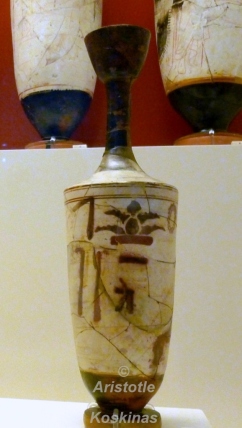Today, our virtual journey will take us back to Athens to explore the true roots of the “Corinthian” order.
I’m putting the term in brackets, because Vitruvius may have said that the Corinthian order was invented in Corinth, but as I’ve already explained, his story is nothing more than a convenient myth.
The truth is slightly different.

The monument of Lysicrates in the historic quarter of Plaka, Athens.
As far as we know, elements of the Corinthian order were used for the first time in Athens. It seems that the order’s characteristic acanthus leaves were a popular motif in the city and may have had a funerary symbolism. This is a conclusion based on the depiction of several grave stele with acanthus leaf details on white Attic lekythoi.

A white-ground Attic lekythos, with a depiction of a grave stele crowned by acanthus leaves.
In architecture, elements of the “Corinthian” style appear for the first time on the Acropolis. The central acroteria of the Parthenon (those on top of the pediments) have obvious “Corinthian” features, such as the acanthus leaves at the base, from which the impressively long and slender scrolls sprout. A little later, motifs that look very much like acanthus leaves were used in the rich sculptural decoration of the Erechtheum, also on the Acropolis.
The earliest Corinthian order column known to archaeologists was in the interior of the temple of Apollo in Bassae of Arcadia. Although destroyed, enough fragments survive to allow its restoration. Could it be a coincidence that the temple’s architect was none other than Ictinus, one of the two architects who built the Parthenon? As an Athenian it makes sense that he would use motifs he had learned in his home city.
In the exterior of a building, the “Corinthian” order was first used in Athens, on the Choregic Monument of Lysicrates. It is one of the best known and most recognisable monuments of Athens, as it stands in a busy spot of the historic quarter of Plaka, within walking distance from the Acropolis.
A Choregic Monument is a monument built to commemorate the victory at a drama or dithyramb competition (a dithyramb was a choral hymn and dance in honor of Dionysus). A choregos was a wealthy man, charged by the city to produce a performance staged in one of the city’s cultural competitions during one of its many festivals. Today we’d call them sponsors, but the term is not accurate, because in Ancient Athens the sponsorship was not voluntary. It was a form of taxation which exploited human vanity to enrich the city’s cultural life. As the choregoi (plural) competed among themselves for the honor of having staged the best performance, expensive dramatists and actors were hired and extravagant sets made, with the most impressive effects possible. The victor would then display his prize on top of a commemorative monument built for the purpose, such as this one.
Lysicrates built his monument in the year 334-33 BCE, after winning at the choir competition held during the festival of the Great Dionysia. He sponsored a choir of teenagers from the Akamantis tribe and his prize was a bronze tripod which he proudly displayed on top of his monument, on a odd looking three-sided capital, which also has several “Corinthian” elements.

The upper part of the Lysicrates monument. Athens, Greece. Above the semi-columns the frieze depicts the capture of God Dionysus by pirates. On top of the roof the three-sided capital on which the tripod was displayed.
Together with the three tholoi that we’ve already seen, the Lysicrates monument is one of the few round buildings that have survived. Besides acanthus leaves, its capitals also have palmettes between the scrolls, which shows how versatile and open to variations the Corinthian order was, even at this initial stage.

A Corinthian capital from the monument of Lysicrates. Athens, Greece.
The story told by Vitruvius is romantic and far too easy, presenting the birth of the Corinthian order as a flash of inspiration by a brilliant artist. The real story is of course much more complex. But even if we admitted the existence of a single creator, without precursors, could this be Ictinus instead of Callimachus?
Whichever the truth, one thing is certain: the “Corinthian” order is directly linked to Athens and proves how important the city’s contribution was to the evolution of Greek, Roman and, later, Western architecture.




Great post, looking forward to exploring your blog over time. As I recall, the pirates’ capture of Dionysus didn’t turn out so well for the pirates.
Thank you. Too true about the pirates; you know your myths well!